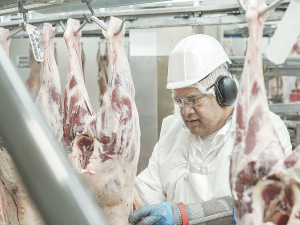US, EU and UK drive NZ red meat export boom to $827m
According to analysis by the Meat Industry Association (MIA), New Zealand red meat exports reached $827 million in October, a 27% increase on the same period last year.
 The sheepmeat sector is bracing for opening lamb prices in November of around $7/kg, equating to $40-$45/head lower than the previous two years.
The sheepmeat sector is bracing for opening lamb prices in November of around $7/kg, equating to $40-$45/head lower than the previous two years.
Lamb prices are expected to remain soft as Chinese consumers struggle to put the effects of Covid behind them.
Lamb consumption in China hasn’t taken off post-Covid, resulting in high inventories in coolstores.
North Island prices last month dipped to $7.20/kg. In the same week a year ago they were $9.10/kg. The South Island lamb price was forecast at $7.30/kg compared to $9.20/kg this time last year.
Meat Industry Association (MIA) chief executive Sirma Karapeeva says the drop in lamb schedules is very much a China story.
“There is a lot of protein sitting in Chinese cold stores,” Karapeeva told Rural News. “The inventory is very high, and they are not buying. I suspect it will take a little while to work through the inventory levels before we see an uplift in demand and price.”
ANZ agriculture economist Susan Kilsby notes that a surge in demand for lamb products that followed China’s post lock-down reopening was short-lived.
Kilsby says Chinese importers were initially positive, pushing up the price of lower-priced lamb cuts and mutton, but they are finding it challenging to move goods on. “Consumption has not lifted as quickly as expected, because consumers remain financially constrained and don’t yet have the confidence to spend as much as they once did on relatively expensive products.”
Demand from importers has since waned, and prices have quickly retreated to lockdown levels. On top of that, a surge in supply from Australia has contributed to the current market imbalance. Kilsby says Australian producers –also hoping to take advantage of the expected pick-up in Chinese demand – had increased exports over recent months.
“The downward trend in pricing now means buyers are holding off in the hope of even lower prices. Added to which, China’s demand for lamb generally weakens over the northern summer.”
Kilsby says we could be waiting some time for any significant improvement.
MIA chair Nathan Guy told the recent Red Meat Sector conference that exporters are facing a lot of headwinds in China.
“Their inventories are full, and the economy has softened,” he says.
Youth unemployment for those aged between 16-24 years is 21%.
Guy says this is a concern because “those are the people who go out and spend”.
The red meat sector is planning a trade trip to China later this year. Guy says the trip will be about creating greater awareness of NZ protein.
“We are going there to wave the flag and make China aware that we are great producers of protein that they need.”
Fonterra shareholders say they will be keeping an eye on their co-operative's performance after the sale of its consumer businesses.
T&G Global says its 2025 New Zealand apple season has delivered higher returns for growers, reflecting strong global consumer demand and pricing across its Envy and Jazz apple brands.
New Zealand's primary sector is set to reach a record $62 billion in food and fibre exports next year.
A new levying body, currently with the working title of NZWool, has been proposed to secure the future of New Zealand's strong wool sector.
The most talked about, economically transformational pieces of legislation in a generation have finally begun their journey into the statute books.
Effective from 1 January 2026, there will be three new grower directors on the board of the Foundation for Arable Research (FAR).

OPINION: It used to be that the National Fieldays attracted brickbats for being officious clipboard carriers, while the regional, farmer-run field…
OPINION: Your old mate welcomes the proposed changes to local government but notes it drew responses that ranged from the reasonable…